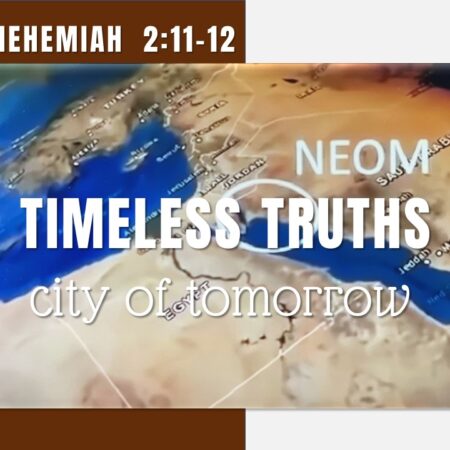Nehemiah 2:11-12
Jude 14
Psalm 68:1-3; 7-10; 17-18 (David speaking)
Ephesians 4:8-10
Isaiah 10:24-26
Isaiah 11:15
Zechariah 10:10-11
Arthur W. Hunt III “The Vanishing Word” published in 2003
“So when Walt Disney bought 46 square miles worth, the citizens of Orlando must have mused how life would be different under the shadow of Mickey Mouse. However, the dreamer form Hollywood was not content to just build another theme park; he was ready to try his hand at building an elaborate city of the future. Upon the Florida flatland, Walt Disney envisioned ‘a City of Tomorrow,’ where dirt, disease, and poverty would be nonexistent; a nuclear-powered metropolis, controlling its own climate and recycling its own waste, a radiant web of white pods connected by silent transit systems. He quietly asserted that the city would be paid for from the profits of his new Disney World. Only a handful knew the scope of Disney’s City of Tomorrow and how it came to dwarf all other projects on his drawing board. Walt Disney never saw his utopia because he died in 1966, just after construction began in Orlando.
The City of Tomorrow evolved into an expanded entertainment haven. Other parks followed. Today Metro Orlando receives more than forty-five million visitors a year. Almost all of us, at one time or another, have made a pilgrimage to one of central Florida’s amusement meccas.
The development of Orlando allegorizes the changes taking place in our own culture. Like Walt Disney’s successors, we also have thrown off our modern visions of utopia for an easier, more attainable, fun land. Orlando serves as an emblematic gauge of an image-driven public, dependent upon movies, television, and video games. Of course, the theme of Orlando’s theme parks is primarily a reflection of the film industry. The Magic Kingdom, MGM Studios, and Animal Kingdom largely exist because of the movies they mimic. Universal Studios created their theme park especially for children and adults who would pay good money to swim with Jaws, fly with E.T., or fight side by side with the Terminator.
It does not take a social scientist to tell us that our culture has an insatiable appetite for visual stimulation. Within the last several years Disney and others have devoted their energies into creating virtual-reality rides, even procuring NASA rocket scientists to design image-enhanced simulators.
In promoting Orlando’s new Island of Adventure, Steven Spielberg predicted that ‘virtual reality will live up to its name for the first time in the next ten years…..because you’ll be surrounded by images…..You’ll feel the breezes. You’ll smell the smells…..Yet when you stand back and turn on a light to look at where you’ve been standing, you’re just in a dark room with a helmet on.’
Spielberg claims that those in today’s generation demand reality in their high-tech recreations.”
Saudi Arabia Unveils the World’s Most Futuristic City Plan
The 100-mile-long metropolis promises to accommodate nine million residents
August 16, 2022
About a year and a half ago, His Royal Highness Mohammed bin Salman, crown prince of Saudi Arabia, announced plans for a utopian-like “linear” city powered by 100% clean energy, saying the country would invest between $100 billion and $200 billion to make the project a reality. Dubbed The Line, the new city was described in a way that resembled the setting of a post-apocalyptic YA novel, where residents would live without cars or streets inside a 100-mile-long futuristic “belt.” Anchoring the kingdom’s green city, NEOM, residents would use autonomous, high-speed transit and artificial intelligence would improve daily life by harnessing data to enhance infrastructure. https://www.architecturaldigest.com
“At The Line’s launch last year, we committed to a civilizational revolution that puts humans first based on a radical change in urban planning,” HRH bin Salman said in a statement. “The designs revealed today for the city’s vertically layered communities will challenge the traditional flat, horizontal cities and create a model for nature preservation and enhanced human livability.” https://www.architecturaldigest.com
Travis Snow “The Passover King”
First, there is evidence that during the great tribulation, many of those in Israel who flee will go to Egypt. Moses references this when he described the various calamities that Israel will face for disobedience to the covenant:
“The Lord will bring you back to Egypt in ships, by the way about which I spoke to you, ‘You will never see it again!’ And there you will offer yourselves for sale to your enemies as male and female slaves, but there will be no buyer.’ (Deuteronomy 28:68)
Again, the context of this is “the last days chastisement” that will befall Israel just before Jesus returns.
Second, there is Scripture that states outright that Jesus will actually return to Egypt. Using the motif of God coming on the clouds, Isaiah declares: ‘Behold, the Lord is riding on a swift cloud and is about to come to Egypt’ (19:1a)’ While some may be tempted to disregard such a passage as mere poetry describing God’s judgments, the second part of the verse states that He will literally and physically be present in Egypt.
‘The idols of Egypt will tremble at His presence, and the heart of the Egyptians will melt within them (v.1b).
In Numbers 24, the prophecy of Balaam seems to indicate that the ‘seed’ and ‘king’ of Israel, (two of the most common motifs for the Messiah), will come out of Egypt, specifically to devour and crush those nations adversarial to Him, His Kingdom, and His people.”

